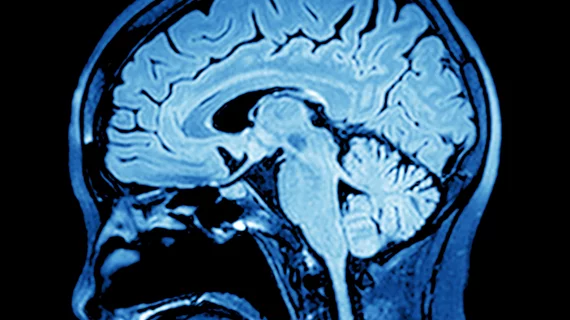Linear gadolinium-based contrast agents are retained at much higher levels in the brain and bones compared to macrocyclic contrasts, according to data published Tuesday.
Radiologists have used such materials in hundreds of millions of patients with no widespread reports tying neurological symptoms to GBCA use, researchers explained in Radiology. Recent investigations, however, have confirmed brain tissue may retain some types of gadolinium agents, prompting renewed efforts to understand the long-term effects of trace material.
Experts compared retention and elimination rates between gadoteridol (macrocyclic GBCA) and gadobenate dimeglumine (linear GBCA) administration. Retention rates for the latter were 3.0-6.5 times higher in the brain, bone and skin, the authors reported.
“This study provides direct evidence that the linear agent gadobenate dimeglumine is retained at several-fold higher levels of gadolinium in the brain and bone compared with the macrocyclic agent gadoteridol,” Masahiro Kobayashi, MD, with the University of Washington in Seattle’s Department of Radiology, and colleagues wrote.
For their retrospective study, Kobayashi et al. included 28 cadavers with either single or multiple doses of gadoteridol and nine with exposure to gadobenate dimeglumine.
Compared to the macrocyclic GBCA gadoteridol, the linear variety produced higher median retention rates in the brain (3-6.5-times higher), bone (4.4-times), and skin (2.9-times). They also reported “nonzero” elimination of gadolinium from white matter and the skin.
Michael F. Tweedle, MD, a radiologist at The Ohio State University, examined the findings in a related editorial, noting gadolinium ion deposits and intact GBCA retention are the two likely sources of trace retention.
Intact GBCAs, he noted, are “very unlikely” to cause long-term toxic effects. And the quantities of ion deposits reported in this study are also unlikely to lead to clinically significant detrimental effects, at least in patients with normal renal function.
Despite this, Tweedle maintained research involving in vivo animal studies, living humans and cadavers will be crucial to better understanding gadolinium’s effects.
“Radiologists and patients need reassurance on the ultimate safety of the use of contrast agents to properly manage the risks and benefits, as is done every day for the use of ionizing radiation,” Tweedle concluded.
Read the entire study here along with the editorial here.
Related MRI Contrast Agent Safety Content:
A deep dive into gadolinium-based adverse reactions
Allergic reactions to iodinated CT contrast increase likelihood of sensitivity to GBCAs
Researchers detail data on gadolinium-related adverse reactions
Radiologists must take a data-driven approach to discuss gadolinium, mitigate liability risk
Radiologists see potential to reduce GBCA administration with new synthetic MRI technique
Gadolinium-based contrast agents are safe, even at higher doses, new research suggests
Gadolinium debate rages on, with radiologist questioning recent GBCA liability guidance
ACR committee proposes new term for symptoms associated with gadolinium exposure
Closing the knowledge gap on gadolinium retention risks
Radiologists find direct evidence linking gadolinium-based contrast agent to higher retention rates
AI software that eliminates need for gadolinium contrast during imaging exams wins patent
Research may offer new method to detect GBCA on MRI
Radiology, other multispecialty groups urge caution with GBCAs during interventional pain procedures
Cardiac MRI contrast agents are low-risk and safe for ‘overwhelming’ majority of patients
Health orgs publish special report about gadolinium retention, GBCA use in imaging
Rodent brains retain gadolinium after repeated administration of GBCA a year after injection
Advanced MRI mapping spots traces of gadolinium in the brain invisible during conventional scanning
Radiologists should keep patients’ best interests in mind to mitigate gadolinium liability risk

